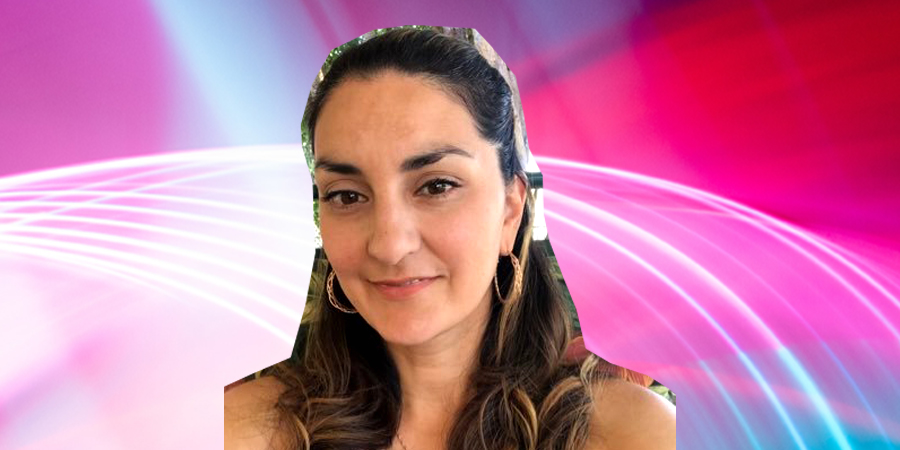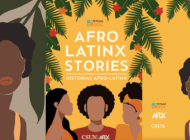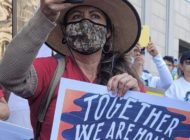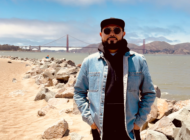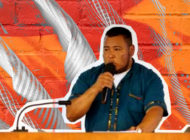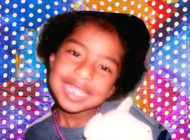El Nuevo Sol’s editor Luis Mirón produced this podcast episode with Dr., Rebecca Romo, professor of sociology at Santa Monica College, who did a short presentation titled “Blaxican Borderlands” for El Nuevo Sol’s staff. The event took place on February 19, 2021.
By LUIS MIRÓN
EL NUEVO SOL
Luis Mirón: Welcome to Radio Nepantla, a podcast from El Nuevo Sol. The multimedia site for the Spanish language journalism program at California State University at Northridge. My name is Luis Mirón. The title of this series is Afro Latinx, we want to tell here diverse stories of Afro Latinx, Black Latinx and Afro Latin American identity. According to the Pew Hispanic center, one out of every four Latinos in the nation identifies as Afro Latinx. This is the same proportion of Afro Latin Americans in that region. We decided to use the term Afro Latin x with x to be inclusive of non-binary people. The umbrella term Black Latinx refers to biracial people with one African American and one Latinx parent, the umbrella term Afro Latin American refers to people of African ancestry in Latin America. In this episode, you will listen to a presentation by Dr. Rebecca Romo, a philosophy and social science professor at Santa Monica College. Dr. Romo addresses some of the issues individuals in the Afro-Latinx community experience growing up. Her personal experience with her own son who is half Arfican American and half Mexican led her to conduct a special research and co-authored a book about the community.
Rebecca Romo: Thank you Dr. Benavides for inviting me to come to your class. I was looking forward to it. My name is Rebecca Romo and I am a professor of Sociology at Santa Monica College, which is a community college in Santa Monica. I have a Master’s and a Ph.D. also in sociology.
I wanted to begin the presentation by talking a little bit about my background. Before I begin to speak about my research, I am sharing with you some pictures from my family. The one that you see to the left is my entire family, my mom, my dad, and there’s actually seven siblings. So, I’m the sixth of seven. I’m the one little one down there in the bottom with the, I guess, a white dress on, and then to the right is a picture of all my siblings and I when we were adults.
My mom—my parents are both from Mexico. My mother, she was born in Ciudad Juárez, but her family is from Jalisco. They immigrated up to the border to Ciudad Juárez. And my mother, she came to the United States when she was three years old. My father, he is from a town called Jalostotitlán, Jalisco. That’s where he was born. And he came to the United States at 13 years old.
…I’m originally from Sacramento, California, which is in Northern California. They went over there because of—just like a lot of families that immigrate, they usually go where their social networks are from or where they have social networks and also where there’s work. A lot of my tías worked in the canneries in Northern California and like the Campbell Soup Factory, for example.
My dad, he did a lot of work, but one of the first things that he did in Northern California was to work in the fields. He picked onions and tomatoes. My parents, they met over there. And then we—you know, there’s seven of us. All my siblings were born there.
I put the title of this slide, “Family and Skin Color,” because I wanted to tell you a little bit about my family background, but also about skin color. I mean, I see, as you can notice, we’re pretty fair skinned. That’s relevant to talking about Blaxican identity and experiences because, growing up—and I know this is not a unique experience. I think a lot of Latinx people experience the whole issues that have to do with skin color. But I remember growing up my dad’s side of the family that are from the town Jaloscotitlán, Jalisco—which is—I’ve never been there myself, but, apparently there’s a lot of people that live there that are very light-skinned. They have blue eyes, green eyes and blond hair.
I remember growing up, my dad and my my uncles, they would always brag about their family members in Jalos that were, that looked, you know, European or they looked White. So, you know, you kind of heard all that growing up. And then, also family members that would use terms, you know, in Spanish to talk about skin color—the positive. There is a positive connotation and also negative connotation, depending on what the term is.
For example, some of those terms like güera/güero, you know, when you hear that usually—or somebody calls you that—usually that’s seen as a compliment. It’s, it’s a positive. And then there are other terms that are more derogatory. Right? So, for example, like I have a family member—no one in this picture, in these pictures—a different family member that would use the term india or indio whenever their kid did something like mischievous. It was like seeing—it was like a negative, like an insult to, you know, to say that.
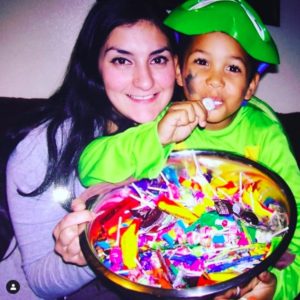 I’m sure I’m safe not telling you anything that you don’t—haven’t possibly already heard. But I come from my family—in a Mexican family. And there you did hear a lot about, like it seemed like they valued more the European aspects of Mexican identity and they devalued the indigenous aspects. And also—and didn’t even acknowledge the African aspects at all. There was never a conversation about, oh, well, you know, Mexicans are laughing and people in general will have African ancestry or African roots. There is a complete denial of that. Even people who identify as Mexican and do have some African ancestry—I mean, in their physical appearance, also deny it. I know people who’ve had that experience. And I know that, you know, they were teased growing up and there was always this like denial of or even acknowledgment that there was any kind of African ancestry in among Mexicans.
I’m sure I’m safe not telling you anything that you don’t—haven’t possibly already heard. But I come from my family—in a Mexican family. And there you did hear a lot about, like it seemed like they valued more the European aspects of Mexican identity and they devalued the indigenous aspects. And also—and didn’t even acknowledge the African aspects at all. There was never a conversation about, oh, well, you know, Mexicans are laughing and people in general will have African ancestry or African roots. There is a complete denial of that. Even people who identify as Mexican and do have some African ancestry—I mean, in their physical appearance, also deny it. I know people who’ve had that experience. And I know that, you know, they were teased growing up and there was always this like denial of or even acknowledgment that there was any kind of African ancestry in among Mexicans.
Now I’m going to fast forward. Growing up in that context, I had my son. This is my son, Emilio. He’s my oldest child who’s now 19 years old. But he… I had him when I was a freshman in college and actually was at Cal State. I went to California State University, Sacramento, and I had him in my freshman year. And I raised him as a single parent pretty much from the very beginning. So, being a parent of a child who I identify as Blaxican. So, this is… Blaxicans are people who have one Mexican or Mexican-American parent and one African-American parent. And not all people who have that parentage identify themselves as Blaxican. I use the term Blaxican—and this was not a term invented by me. I’ll talk more about the interviews that I did with people in the United States. But it was not something that I invented. Something that I heard of, though. And so, when I gave birth to my son… when I was pregnant with him, I did have some family members that were upset because… I was actually the first person in my family to be in an interracial relationship. You know, my dad was disapproving. But the way that he explained it was that it was because of religion. He said, “you know”… I grew up Catholic and my family, they’re Catholic. For him, he would always just ask me, “what religion is he going to be?” My son’s father and his family, they actually are agnostic. They don’t practice religion at all. But the assumption was that, you know. I don’t know what my dad thought they were, maybe Baptist. I’m not sure. Like as a stereotypical image. But he used the excuse of, like, religion.
“You know, what religion is he going to be in?” You know, I remember pointing out to my dad one time, I said, “you know, Dad, we have cousins that are darker than my—if it’s about skin color,” I don’t know. We have—I have cousins that are darker than my son’s father, you know. And so, you know, there is just disapproval. I had one of my brothers that I grew up with living in the same house we lived in.
I grew up very—we are actually very low income. So at the time, my dad, he was—we were on food stamps, welfare. My dad wasn’t working. We were living in—renting my uncle’s house, two-bedroom, small house in Sacramento. The house my parents still live in now. And so, I lived in that house while I was pregnant. I was a teenager with my siblings and one of my brothers. He refused to talk to me the whole time I was pregnant. No, we lived in the same house, little house. And he didn’t talk to me at all the whole time I was pregnant.
Then, when I gave birth to my son, all of my siblings came to see me at the hospital except for that one brother. But when I came home, I brought my son home. And, you know, like after you give birth, it’s like. It’s well, it’s difficult, you know, so you ask for help, and I remember one time I asked my dad if he would hold my son while I took a shower. And every time I get emotional, every time I tell the story. But when I got out of the shower, my son was laying on my brother’s chest. You know, the one that never talked to me the whole time. I’m not trying to say that my son’s birth changed their anti-Black attitudes, but I did see I did notice something in them that did change. I’m not, you know, like people say, oh, multiracial people are like this. Solving racism. Right. I’m not trying to say that that’s what that is. But I did notice that there was something that did change in my brother because after that, he. You know, growing up, like, look, I’m sure everybody has some kind of awareness of this.
Latinos, and I’m going to say specifically Mexicans, because that’s what I am and I’ll speak from that experience. You know, our anti-Black—there’s a lot of anti-Blackness. There’s a lot of—you hear it a lot. You know, people openly talk like that. And so I had in my own family, they would. And after my son was born, at least I didn’t hear from them anymore. I don’t know. I hope that in their heart they have changed. But at least they knew better not to talk that way in front of me.
I also had some family members that would like, when he was born, they said, “oh, he’s so dark.” I also had another cousin who suggested after my son was born that because his nostrils are a little wide, that I do rub his nose like this and keep doing that. And that would make his nose narrow. And I, I remember looking at her and saying, “you know? That’s how his nose is supposed to be, and I’m OK with it.”
And then the other thing I told her was, if that actually worked, we wouldn’t have plastic surgery. Thank you for trying to do that favor for me, but… And she was being one hundred percent sincere, like she thought she was actually giving me good advice. Like, not a joke. Not funny, but giving me, like, solid advice.
I also had another cousin who told family in Mexico that night that his father is Puerto Rican, which is not true in that kind of speaks to that racialized hierarchy. So, in my uncle’s view, it was better to say Puerto Rican than to say Black, you know, because of the way that we categorize people into these hierarchies of which one is more valuable and which one is less valuable.
And now I have… we call ourselves a Black-Latino family. This is actually my husband and we’re a blended family in many different ways. You know, we had children before our relationship and we also have one together, which is the little boy in the blue that’s being carried by my stepson. That’s our son together. But all of my family members are in some way Black and Latino. Two of my stepchildren are Costa Rican and Black. And then the others are Mexican and Black. And then my son, one of my stepsons, is actually White and Black. But we are, you know, a blended family. This is us.
This is the way that we experience our lives in L.A. And it’s pretty interesting because we live in. Well, I live in Sylmar and, you know, it is part of the northeast San Fernando Valley—is very Latino. It’s predominantly Latino. We have some interesting experiences with… depending on where we’re at. Honestly, we don’t really get a lot of looks unless we’re in certain parts of the Valley, like, for example, like certain parts of Northridge, sometimes in the west end of the Valley. People stare. Over here, they don’t stare too much. I’ll talk more about the personal life, personal experiences a little bit later.
But I wanted to move on to the research. The chapter that you read, that was based on my dissertation research, which I’m actually turning into a book manuscript right now, and this hopefully will be published by next year. But what I did was I interviewed people who are Blaxican, who have one African-American parent, one Mexican, Mexican-American parent in the United States. And so I did a total of 40 interviews. All of them were adults. And that had to do with…in sociology. We have to get approval through the what is it called Institutional Review Board, which is like a very rigorous permission to interview people and so it’s easier to interview adults than it is to interview children because of the permissions. I mean, it wouldn’t have been impossible, but I went with adults and most of the people that I interviewed were from California. However, they were also part of nine other states, including New York, Indiana, Georgia, New Mexico.
Like I said, their biological parents are African-American and Mexican-American and they consider themselves to be the first generation. We’re all, quote unquote, what they would call racially mixed, right? There is no such thing as a pure race in terms of biological. But what I mean by first generation is they consider themselves to be the first of that mixture between an African-American parent and a Mexican, Mexican-American parent. This is different than Afro-Latinx experiences and identities from Latin America or Afro. Let’s say Afro Mexican, for example. Who. People that are Afro Mexican in places like the Costa Chica region of Mexico. They’ve had multiple generations of this mixture. Whereas Blaxicans are more… they consider themselves to be more of a first generation… and their racial formation is specific to the United States. And I’m sure if you have questions, we could talk more about that and what that means.
And then I just want to talk about this picture that you’re seeing. So these are actually children from my family. And the mural that you see in the background is actually a Saint. Padre Toribio Romo, who is supposedly, according to my father, somehow part of his relation. He was he’s a patron saint of immigration, I believe. And he is from the town where my dad was born. Jalostotitlán or Santa Ana, I believe, which is like a little village right outside of it. This is in my uncle’s backyard. One of my cousins, he’s a muralists. He painted that.
And I just thought, you know, I took that picture a long time ago, but I thought it was the interesting connection because of, you know, here you have descendants of the Romo lineage. Right? And they’re Afro, they’re Blaxican, Black and Mexican.
Just a little about the emergence of Black identity, so in the United States in 1967, here was a U.S. Supreme Court case that legalized marriage between people of different races. All the way up till 1967, which was not that long ago, there were laws in different states in the US that prohibited people from intermarrying with one another if they weren’t from the same race. After 1967, there was an increase in interracial marriages and also multiracial births. As I’ve said before, there have this idea of multiraciality is not something that’s new. It’s a social construct. It’s this an idea that that people believe to be real. I guess what I’m trying to say is there’s always been multiracial people. It’s just that after 1967, you had more that identified themselves consciously as being multiracial…
Mexicans started migrating outside of the southwest, which is the traditional place for migration into places like Georgia and Indiana and New York. That kind of set the stage for these interracial marriages between Mexicans and African Americans, because Mexican and African Americans tend to work in the same kind of industries. You know, low wage labor working. And so, for example, this is an actual respondent that I interviewed and his parents. He is from Indiana and his parents met working at a factory in Indiana. And so his mother’s Mexican and his father is African American. They moved to the same neighborhoods. They worked in the same places. And so, that kind of just set the stage for these interracial marriages and multiracial births.
Blaxicans started to or with the increase of these multiracial births. They started to identify outside of what we call Black, according to the one drop rule. In the United States, there was a law. There were laws on the books in different states that said that if you had any amount of African ancestry, that you were legally designated as Black. And then, it became more not so much a legal construct, but a social construct. Anybody who has any amount of African ancestry is socially designated as Black. That’s why we can look at former President Barack Obama, who has a white mom and a Black father from Kenya, and look at him and say he’s just Black. Nobody looks at him and says he’s white. Right, because of the one drop rule. And so, Blaxicans, they kind of represent this moving away from identifying as Black, using the one drop rule, which is the way that a lot of people who were mixed with Black previously would identify because not just like, well, legally. Because of… because of socially. That’s how people view who is Black.
My research questions centered around, I wanted to know how people identified and why it was that they were identifying in the way that they did. These are all pictures of family members, children from my family. And at the time when I was before I was when I was an undergraduate, before I went to grad school, I only knew Blaxicans that were children from my family. I wanted to learn more about that. And I was also interested in Black-Latino relations generally. So, when I went to UC Santa Barbara, I met my… who is became my mentor. And I’m actually coauthoring the book with Now. G. Reginald Daniel. And he was one of the first people to teach a class on multiracial identity at UCLA. And so it kind of just all fell into place when I went to grad school.
I don’t really know that’s what I wanted to research. But I had my Blaxican son, and I was interested in looking at Black-Latino relations and it kind of just all fell into place. So just there’s only a couple more sides… and we can have questions. But just a couple of things that I found. And you’ve read the chapter that your professor provided you, but I found that Blaxicans identify, the ones that I interview. They identify as both Black and Mexican, regardless of what their appearance is, because some Blaxicans have more of an appearance that people mark them as Black and then you’ll see in the next slide. Sometimes the I’ve interviewed people who either are perceived as racially ambiguous or they might fall more towards people perceiving them as being Mexican or Latino. And so regardless of physical appearance, they identified as both… Black and Mexican, and they also saw Mexican identity, not just in terms of ethnicity, which is how the U.S. Census categorize who is quote unquote Hispanic is as a culture. They also saw it as a race, a race as well. So, they viewed themselves as both racially and culturally Black and Mexican, which also in the next slide kind of talk a little bit more about that.
But the picture that you’re seeing here is a woman that I interviewed, Enedina and her mom… and she is from Indiana and actually she’s the sister of the other person I was talking about on the previous slide. And so that’s their mom. And she her their parents met. And like I said, at a factory that they worked out together in Indiana. So this is Guillermo, a person that I interviewed. He is actually a twin. His twin brother—they’re fraternal, they’re not identical. So that was really interesting because they both had these very different experiences based on their physical appearance. Because Guillermo, he you know, if you can look at his picture, he had his hair is straighter. He has lighter skin. And when people look at him, they didn’t perceive him as being Black, even though his mother’s Black and his father’s Mexican. And so he would do things like in college, like join. He joined a fraternity that was a multicultural fraternity. And there was these different strategies. He said that he would use to let people know that, you know, he was not just Mexican, but Black as well, you know? And so it’s really important for him, for people to know that he was both Black and Mexican.
It’s something in the book that I write about some of the strategies that they used to like not only embrace both being Black and Mexican, but how they represent that to other people or how that is become so important in their lives that they do things like, for example, like hair became it was a very hot topic that people talk about a lot, not just the women, but the men as well. And so, like wearing their hair in certain kinds of hairstyles, growing it out and putting it into dreadlocks, you know, that kind of represented the African or the Black side of themselves. And so Guillermo said, I usually say I’m Blaxican, because I don’t want to deny both of them. I always say Blaxican off the top. People already know what I’m talking about.
Black skin becomes like this easy way for you to understand that they’re both Black and Mexican. And there’s other terms that people use as well, like Afro-Chicana, Afro Mexican, even though it doesn’t mean exactly the same thing as when we think about African Afro Mexicans from Mexico. A little bit different. OK. And so what ways that they learned about their hybridity or this mixture of not just racial identity, but also cultural identity was through their parents. So my parents exposed me to both my cultures through music. So they talk about music a lot. The different kinds of music that their parents listen to. We eat outside. We eat soul food and enchilada. So also talked about like different kinds of food that was served on the dinner table. And it wasn’t like they always, you know, like a mixture of both at the same time. But one day they might have eaten collard greens and then the next week their mom prepared menudo or something.
And then there was also, you know, navigating anti-Blackness, which is something that I when I started the presentation, I talked about it from my own experience. But this is Latoya and her mom who’s Mexican. Her father’s African-American. She was raised primarily by her mom and also her grandparents, who are Mexican and only speak Spanish. So, she said, my mom always made it clear to me to talk to me about why I was different from other people. My grandparents helped raise me and they didn’t speak English. I had episodes of kids calling me names, calling me the N-word in elementary school and even junior high. I had my grandpa who told me that I wasn’t Black but Mexican. And so that was a pretty common theme that came up, especially on the Mexican side of the anti-blackness. I don’t think that Latoya’s grandfather was trying to tell her that she wasn’t Black in a way. I think. Let me rephrase that. I think he was more trying to instill a pride of being Mexican. But at the same time, he was denying her Blackness. And I say that because it’s really complicated. You know, and is very nuanced because she talks about her grandparents in a very caring and loving and compassionate way. But at the same time, having to deal with comments that came from her grandfather. And having to constantly negotiate that and then having always like her mother, who is on her side, that is instilled this pride in her of being both Black and Mexican and not feeling ashamed of being Black, but giving her encouragement to embrace her Black identity. And so this is kind of just some of the nuances that you find in the whole negotiation of what it’s like to be both Black and Mexican.
Then I know because I’m I don’t want to take too much time and I want to give some time for Q&A. But I wanted to just end this part by talking about where I started, which is about my experiences with my son. So, this is on the right-hand side. He would probably hate that. I am using those pictures right now. If he knew. But on the right hand side, he turned 18 last year and he this was actually him right after he voted in Michigan, which is where he’s at in college right now. And so was really proud of this picture because first time that he voted and he had to stand in line for two hours, you know, talk about voter suppression… on his birthday. It actually was one of birthday that he voted. And then the other picture asked him and I when I first time I went to go see him play soccer in Michigan, his first one of his first time, I saw him play soccer in college. And so just a little bit about our our own experiences.
I raised them mostly in Southern California. I went to get my Master’s and Ph.D. at UC Santa Barbara. And then we moved here to Southern California, to Sylmar, actually, when he was probably like eight years old. And so I grew up in Sacramento. It is segregated. But in my in my opinion, it’s segregated mostly by class, not by race. And when I moved to L.A., this is the 10th most segregated city in the country. And so. It was a different experience coming in, living around predominantly Latinos, which is what my neighborhood is. I think we’re like 90 percent here. And so the experiences with him going to school in. Was that of a lot of Latinos, his classmates. They didn’t see him as Mexican. Not even as half Mexican. Even if they saw me, they saw me drop me off and talk to their parents. They never saw him as that. He has been called the N-word. You know, I would say starting in fifth grade was the first time that he was called that by by Latinos, as the thing, too, is like the. It’s very painful. You know, when people from the group that you see yourself as being a part of are the ones that are hurtful in that kind of way. And I’m not trying to say Latinos are the only ones that are like that because we know there’s a lot of anti-Blackness in every single group, right—that’s not Black. But there was like a lot you experience a lot of anti-Black and it’s now as painful as a parent because, you know, as a parent, I wanted to go up there to the elementary school. You know, what you feel is that you want to go and pull on a little kids here or you want to talk to their parents or you want to do something. But, you know, my husband always calmed me down. OK, so, you know, he experienced that.
And then he went to Sylmar High School and played soccer. He was on the soccer team. And that was an interesting experience, too, because. While they were his teammates and him playing soccer and being athlete, it’s been very eye opening because he’s been called the N-word also like on the soccer field, not by his own teammates. But, you know, by other teams, and so his freshman year at Sylmar High School, there was actually a fight. And some of you I don’t know. It was on the news. I know there’s a lot of things on the news. And it was a long time ago, but there was a fight between they happened to be between African-American students and some Latino students. So it kind of turned into this, like, racialized event in sort of a way where. It had to do there have to be honest. It was like supposedly involved a gang. And so the gang supposedly put a, quote unquote, green light on all the Black students, which is green light means that when you see them on sight, either, well, actually means kill them. And I don’t know if it was all that serious, but some kind of violence, you know. And it was, you know, him being both Black and Mexican. It was really difficult kind of time to navigate. A lot of African-American students actually ended up leaving school. And then some of them ended up staying there.
But I do remember I canceled all of my office hours after classes to drive all the way from Santa Monica to Sylmar to pick him up after school and drive them home because I didn’t want him walking through the neighborhood. You know, my husband says I exaggerate, but it’s because he he lives here. He’s he’s been like he grew up in Brooklyn. So, you know, he he has a different experience. But for me, it was like I’m not you know, I’m not going to take any chances. And I wasn’t the only parent that felt that way. Latino parents and also African-American parents, we’re both worried about our kids. And there was actually. Well, you all can ask me more questions about that, I want to go on and on. If you’re curious, but. One of the reasons that I did this work, and I like to share this work, is because Mexicans in particular and Latinos in general don’t we are not aware of the African ancestry, African roots that we have in the more awareness that we have of that. I think the less kind of anti-Blackness, indiscriminate discrimination and prejudice that we have towards one another with the more awareness that we have.
A lot of people like not even, you know, sometimes even Blaxicans and other Latinos, they don’t even know that we have Afro Latinos. They don’t know that Afro Mexicans exist in Mexico. They don’t know that Mexican culture is actually influenced by African culture in a lot of ways. One of the most famous songs that people recognize, which is La Bamba, which is, you know. Made famous by what they call what they started calling him, Ritchie Valens, which is right here in the San Fernando Valley, is actually a song after this African tribe called The Mom Bomba. And so that the song is actually originates from people who were enslaved, Africans that were enslaved in Veracruz, the zapateo, which is a dance that ethnomusicologists, they’ve traced this dance step, which is like the tapping. Right. If anybody’s ever danced Folclórico, you learn to do that dance step. And it’s actually an African down step. Know we can trace that back to Africa. Also food and, you know, Latino culture and specifically in Mexican culture, supposedly—agua de Jamaica. And then one scholar, he actually argues that even Mexican rice, the cultivation of rice actually comes from Senegal. And so there’s you know, there’s so many things about Mexican culture that has its roots in Africa.
And we don’t recognize our relation. Right, because of the history of colonization, imperialism and slavery that has taught us that the worst thing that you can be is Black. Right. In the devaluation of Blackness, when actually if we look deeper into the roots. Latinos have African ancestry as part of their not just physical embodiment, but also in the culture itself.
Tags: #AFLX Black Blaxican latinx Luis Mirón podcast Radio Nepantla Rebecca Romo







